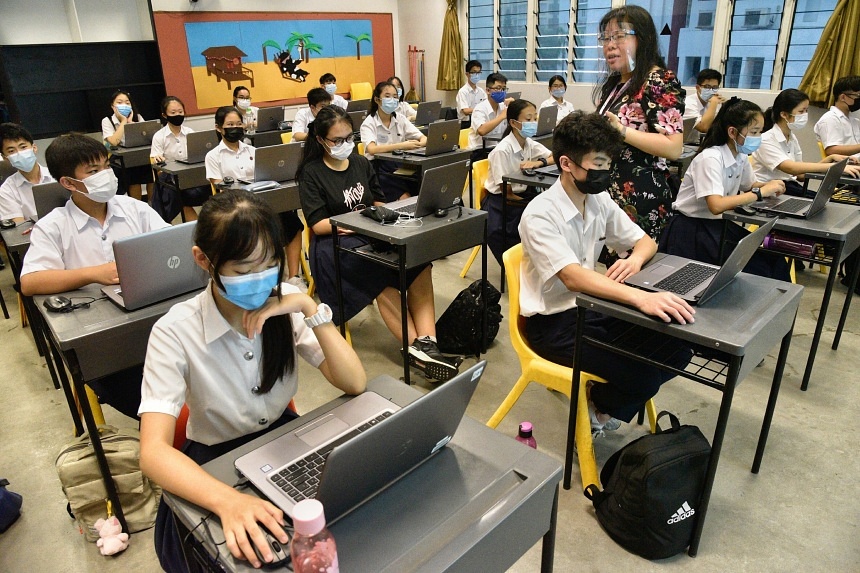- Joined
- Jul 25, 2008
- Messages
- 15,336
- Points
- 113
Address teachers’ heavy workload, not just the inconveniences
While it is good that teachers don’t have to respond to work-related messages after school hours, their biggest problem is simply that they’re overstretched.

Elisha Tushara
Correspondent

It’s time to consider reforms that prioritise teaching quality and teacher well-being over multi-tasking ability, says the writer. PHOTO: ST FILE
Sep 24, 2024
SINGAPORE – Before I left the teaching service in April 2023, I was in 15 WhatsApp chat groups that were related to work.
These included chat groups with my form class of 37 Secondary 3 students, 12 English language department teachers, 35 drama club students and 11 subject teachers who also taught my form class.
More than half of these groups had important messages I had to take note of, or reply to, on a daily basis.
Sometimes after five periods of back-to-back lessons, I would check the notifications on my phone and shudder seeing the number of unread messages.
This came to mind when Education Minister Chan Chun Sing said on Sept 18 that teachers do not need to share their personal phone numbers or respond to work-related messages after school hours.
The aim of these new guidelines, he said, is to ensure educators have protected time to spend with their families, rest and recharge.
This is a step in the right direction. I do not think, however, that it will afford teachers more “me-time”. Teachers have many demands on their time and taking calls after school hours is just one issue, and perhaps not even the biggest one.
For one thing, the scenario of parents hounding teachers over trivial issues like spelling lists and which attire to wear is probably more common in primary schools, where most children do not have their own mobile phones.
And when I taught in secondary school, I seldom encountered the challenge of being overly accessible to parents or students after school hours.
The messages I received were typically from students, five minutes before the morning flag-raising ceremony, telling me that they were in the toilet with a tummy ache and would not make it for assembly.
So if you tell teachers that they won’t be disturbed after school hours, they will thank you. But they will also ask you to look at other aspects of their job that make it difficult.
One hat too many?
What truly drains teachers of their time and energy is the range of responsibilities they have to juggle.The work that teachers need to handle during the school day often spills over into their personal time after school.
Teaching is just one small part of a teacher’s job.
The hours I spent in the classroom were often dwarfed by the time needed for lesson preparation, marking, meetings, organising events, managing co-curricular activities (CCAs), conducting remedial lessons, handling disciplinary issues, performing committee and department work, as well as national examination duties.
Teachers and parents say new guidelines can help set boundaries, but some worry about implementation
Podcast: Parents need to partner with teachers, not see them as service providers, says Chan Chun Sing
Teachers are pulled in many directions, often forced to balance the expectations of teaching in classrooms effectively with the numerous additional “out of classroom” duties.
The issue is systemic, and no amount of after-hours relief can address the exhaustion caused by overburdened schedules.
I’ll use myself as an example.
On a typical week day, I’d arrive in school before 7.15am and head over to the parade square for the flag-raising ceremony.
I’d mark my form class’ attendance, and message students who had not arrived to check if they were late or unwell.
My first lesson would start at 7.45am, and each period was 45 minutes long. I’d get a one-period break at 10am, which I would use to snack, print materials for the next lesson and squeeze in some marking.
After another two periods of lessons, I’d get my next break at 12.15pm. This time was spent having lunch, responding to e-mails and WhatsApp messages, and preparing the next lesson’s materials.
Since I was in charge of the Secondary 3 English lesson materials, I’d also use this time to print out the week’s resources for my colleagues and place the materials on their desks.
At 1.45pm, I’d begin my last two classes of the day. I’d finish at 3.15pm and quickly head over to the drama club room, to open it for students and the trainer before the co-curricular session started at 3.30pm.
Along the way, I’d meet three errant students and tell them to start on essays that were overdue.
While the CCA was ongoing, I’d go back to the staffroom and see two test papers on my desk that I needed to vet and pass on to my colleagues before leaving school for the day. So I’d grab the papers and my laptop, and head back to the drama club room, where I was stationed till 6pm.
I’d take attendance and start calling up the parents of students who did not report for their CCA.
I’d complete the vetting of the test papers and run up to the staffroom to hand them to another teacher, while trying to locate one of the students who had yet to submit his overdue essay.
Back in the drama club room, I’d read an e-mail about committee work. As a member of the spatial and learning environment committee, which is tasked to improve the school’s infrastructure, I was responsible for duties such as writing synopses for 10 student artworks to be displayed around the school.
After dismissing my CCA students and firming up administrative details like rehearsal timings, I’d look through the next day’s timetable to ensure all was in order.
I’d notice that some niggling tasks such as drafting a letter to parents, booking a bus and catering snacks had not been done. But since it was already a little past 6pm, I’d leave them for the next day.
By the time I finally collected the three essays my students submitted late and drove home, it was almost 7pm.
While spending time with my children and having dinner with them, my mind would also be on the three essays I needed to mark after they went to bed.
So while this new policy may offer some relief to teachers and set some boundaries, it is merely a small Band-Aid on a much larger problem – the excessive workload which pressures teachers to perform and also overwhelms them.
21st century problems
The ministry has taken some steps to lighten teachers’ workload in recent years, including giving schools greater flexibility to pace the implementation of some initiatives, and experimenting with technology to support some tasks like planning lessons and administrative work.But challenges persist. Teachers do so much more than just teach, and the job has become very complex in the last decade. Today, they are expected to weave technology into lessons, use hybrid learning platforms and manage students’ use of personal learning devices while ensuring they remain engaged.
Teachers also have to cater to an increasingly diverse profile of students with behavioural issues, special learning needs or mental health concerns. Discipline in schools can get more challenging with problems like vaping and cyber bullying. The push to develop “21st century skills” like creativity, collaboration and problem-solving has resulted in several curriculum reviews which teachers have to stay on top of.
All these developments are necessary and good, but does a teacher need to wear so many hats? Being spread so thin may in fact do a disservice to students under their charge.
Beyond the core duty of subject teaching, some educators are better at connecting with students, some have a passion for certain CCAs, others prefer reviewing broader school policies and brainstorming for new ideas, while some are adept at refining the curriculum for different student profiles.
Instead of expecting teachers to perform a variety of tasks and evaluating how effective they are across all of them, one way is to give them space and time to find their niche and where they can make the most difference.
It’s time to consider reforms that prioritise teaching quality and teacher well-being over multi-tasking ability.








